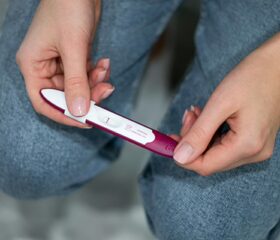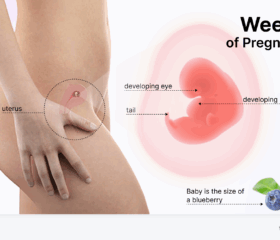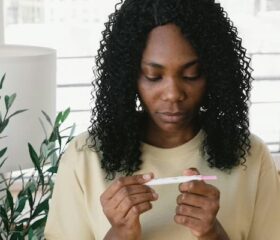Pica During Pregnancy: Causes, Common Cravings, & Treatment
Pregnancy is full of surprises, and sometimes, it isn’t just the odd cravings for pickles with ice cream. If you find yourself eyeing the soil in a potted plant, you might be experiencing pica.

While it might seem odd, pica, a condition where you crave non-food items, isn’t unheard of during pregnancy. Feeling the urge to consume unusual substances is nothing to be ashamed of—it’s just a mental health condition like any other, and it’s very treatable.
Let’s look at exactly what pica is, what can cause it, and what the next steps are if you have it.
What is pica?
Pica is an eating disorder where you have persistent cravings for (and may even consume) non-nutritive, non-food substances for at least one month. 1
To be clear, these cravings go beyond the occasional pregnancy hankering for strange food combos or any of the usual foods you should avoid during pregnancy. Pica cravings involve items that offer no nutritional value.
With pica, you usually still eat regular food, but also feel compelled to consume things like dirt, paper, or ice (in the last case, this means really eating ice, not just having a few chips because you find them soothing on your throat).
The word “pica” comes from the Latin word for magpie—a bird known for eating just about anything. 2
The different subtypes of pica
There are three subtypes of pica, which differ based on the type of substances you crave: 3
- Geophagy: When you crave earthy substances like clay, dirt, or chalk.
- Amylophagy: When you crave starches like raw flour, cornstarch, or even laundry starch.
- Pagophagia: When you compulsively eat ice.
Along with those common forms of pica, pregnant women may also crave: 3
- Charcoal, pebbles, or stones
- Paper, paper towels, and toilet paper
- Ashes
- Baby powder
- Coffee grounds
- Eggshells
Are there any other symptoms of pica?
Again, the primary symptom of pica is the desire to compulsively consume foods that have no nutritional value. If you actually give in to your cravings, you may get unpleasant side effects from eating these non-food items, which can manifest as conditions like constipation or anemia (more on this later). 4
How common is pica during pregnancy?
Pica is actually fairly common in children, with about 25%–30% of kids having it. 5 As for pregnant women, the true prevalence isn’t known.
One 2021 meta-analysis suggested that approximately 28% of pregnant women worldwide may experience pica at some point. However, it’s worth noting that this study found that the rates of pica were highest in geographic regions with a lack of education. 6
All cravings tend to be stronger in the second trimester
Cravings are one of the most notorious pregnancy symptoms. In many cases, pregnancy cravings start early in the first trimester and intensify during the second trimester. 7 If you suffer from pica, you may find it’s at its strongest during your second trimester, too.
What causes pica during pregnancy?
While experts still aren’t exactly sure what causes pica, there are a few factors that might contribute to it:
Anemia & nutritional deficiencies
One common purported cause of pica is anemia, which usually comes about due to a lack of iron. 3 Deficiencies in zinc and calcium may also play a role. 8
Unfortunately, if you give in to your cravings, that might actually make your deficiencies worse. Non-food items like clay or starch can bind to minerals in your digestive tract, which limits how many nutrients your body absorbs, creating a vicious cycle. 4
If you crave (or even ate) any strange or specific items, keep a log in your journal or in your pregnancy tracker app so you remember to bring it up with your doctor.
Psychological and cultural factors
Stress, anxiety, and unresolved trauma can all increase the risk of pica during pregnancy. Pica is also associated with obsessive-compulsive disorder (OCD) and other mental health conditions. 9
According to the National Eating Disorders Association (NEDA), pica is a recognized mental health disorder that may appear in tandem with other mental health conditions. 1
It’s also worth noting that in some cultures, eating clay or soil is a traditional practice for comfort and nutritional benefit, which might explain some instances of geophagia. 10
Is pica dangerous during pregnancy?
Pica can pose risks for you and your baby, which we’ll examine more closely below:
Your risks
You may experience nutritional deficiencies, as these non-food items can crowd out actual food and interfere with your nutrient absorption. You also risk exposing yourself to toxins—paint chips may contain lead, for instance, and soil can harbor parasites, bacteria, or harmful pesticides. 11
If you eat contaminated soil (or didn’t wash your fruits and veggies properly), you may experience fever, muscle aches, and nausea. These are symptoms of listeria (a harmful kind of bacteria), which can have disastrous consequences for your baby, too.
You could also suffer from digestive issues like constipation, bowel obstructions, or even gastrointestinal injury, and you might also damage your teeth. 4
Your baby’s risks
If you have pica, you’re more likely to expose your baby to toxins and put him at risk of nutritional deficiencies. As a result, your baby could be born prematurely, with a low birth weight. In severe cases, this exposure can be fatal. 3
Even if your baby is born at term, he may have long-term developmental or behavioral issues, such as learning disabilities, especially if you consume toxic substances like lead or pesticides. 3
How do doctors diagnose pica during pregnancy?
There’s no single test for pica, but your doctor may ask you about your symptoms, cravings, and eating habits. If they suspect you have pica, they’ll run blood tests to check your levels of iron, zinc, and electrolytes to see if you have any vitamin deficiencies.
They’ll also check if you have any toxic substances in your system, like lead. 11
How is pica treated during pregnancy?
If your doctor diagnoses you with pica, you’ll need to go in for regular checkups to track your nutrient levels, cravings, and your baby’s development.
Your doctor will also suggest a combination of treatments to manage your pica:
Correct nutritional deficiencies and find alternatives
Your doctor may prescribe supplements like iron or zinc if you’re lacking nutrients. You should also make sure your diet is full of foods high in iron, including red meat, leafy greens, and beans. 4
If you don’t know where to start with your pregnancy diet, your doctor can put you in touch with a registered dietitian. They’ll help you build a meal plan that ensures you get all the nutrients you need while satisfying your cravings.
You could also try swapping non-food items for safer and healthier pregnancy snacks. For example, try eating cold or frozen fruit if you’re experiencing ice cravings or chewing strong mints or gum for soap and crayon cravings.
Behavioral therapy
Often, pica is a symptom of an underlying mental health issue. You may find that cognitive behavioral therapy (CBT) with a trained mental health professional helps you identify triggers and develop coping strategies. 4 If your cravings get too strong, find ways to distract yourself, whether that means chewing gum, knitting, or going for a walk.
In severe or treatment-resistant cases, your doctor may consider medication to manage any mental health conditions you’re suffering from. 4
Environmental changes
As well as keeping your diet and mental health in check, you should also ensure that non-food items are out of reach, and avoid activities or places that could trigger your cravings, like gardening if you crave soil.
When to talk to your doctor about pica
If you crave or consume any non-food items (even if it’s just ice), let your doctor know right away. You should also let them know if: 1
- Your unusual cravings are affecting your mental health
- You have symptoms of anemia (fatigue, pale skin, and shortness of breath)
- You experience digestive problems, abdominal pain, or nausea
- You suspect you have symptoms of poisoning or exposure to toxins (e.g., lead, chemicals)
You may feel confused or even embarrassed about having pica during pregnancy, but you’re not alone. These abnormal cravings often come about from an underlying nutritional or psychological issue, so it’s important to get in touch with your doctor as soon as possible.
With their help, you’ll be able to manage your pica and make sure you and your baby are safe throughout your pregnancy.
Article Sources
- National Eating Disorders Association. "Pica" Retrieved July 23, 2025.
- Pediatrics. "The Origin of the Word Pica" Retrieved July 23, 2025.
- StatPearls. "Pica" Retrieved July 23, 2025.
- Cleveland Clinic. "Pica" Retrieved July 23, 2025.
- American Pregnancy Association. "Pica Cravings During Pregnancy" Retrieved July 23, 2025.
- International Journal of Gynecology & Obstetrics. "A meta-analysis of the worldwide prevalence of pica during pregnancy and the postpartum period" Retrieved July 23, 2025.
- Tommy’s. "Pregnancy cravings and food aversions" Retrieved July 23, 2025.
- American journal of mental retardation. "Effects of serum zinc supplementation on pica behavior of persons with mental retardation" Retrieved July 23, 2025.
- Indian Journal of Psychological Medicine. "Onset of Obsessive Compulsive Disorder in Pregnancy with Pica as the Sole Manifestation" Retrieved July 23, 2025.
- Journal of the Royal Society of Medicine. "Geophagia: the history of earth-eating" Retrieved July 23, 2025.
- MedlinePlus. "Pica" Retrieved July 23, 2025.







